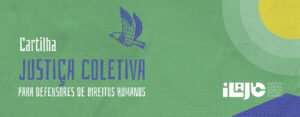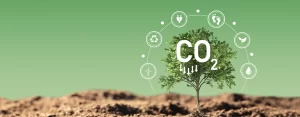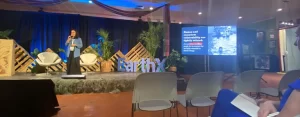In view of the growing concern about the impacts of climate change, both countries and companies recognize the need to reduce their carbon emissions and offset those that have not yet been avoided. This urgency, combined with the Nationally Determined Contributions (NDCs) of the countries that signed the Paris Agreement, has brought the climate discussion to the economic sector. In this context, the carbon market has emerged as a possible solution, offering opportunities to address socio-environmental challenges and obtain economic benefits.
The carbon market involves the purchase and sale of credits generated by greenhouse gas (GHG) emissions offset projects. These credits represent a resource transfer tool designed to promote action against global warming and achieve emission reduction targets.
In general, each carbon credit is equivalent to one ton of carbon dioxide equivalent (CO2e), a standardized unit of measurement that encompasses all GHGs based on the global warming potential of carbon dioxide (CO2). The value of each credit varies depending on the market in which it is traded: regulated or voluntary.
In the regulated market, governments establish emission reduction targets or limits through legislation applicable to the sectors responsible for the emitting sources. Companies that emit less than the established quota have the option of selling their carbon credits to those that exceed the quota. In this scenario, the price of the credit is determined by the regulatory body.
In the voluntary market, the value of the credit is established based on the implementation of carbon projects and the certification of carbon credits for their commercialization. Companies acquire these credits to offset their emissions, often as part of their corporate social responsibility goals. In addition to sellers and buyers, this market also includes financiers, project developers and regulatory bodies, known as registration programs or international standards.
The Different Categories of Carbon Credit Projects
Carbon credit projects can be implemented in several categories. Let’s explore this diversity, using the Forest Trends Ecosystem Marketplace classification as a reference.
The Agriculture category includes project types centered around sustainable management of agricultural lands and pastures, including preservation and restoration of natural ecosystems, management of animal manure and fertilizer emissions, and methane reduction through sustainable rice cultivation and methane biodigesters.
Chemical Processes/Industrial Manufacturing includes projects that improve the efficiency of industrial processes, as well as those that capture and destroy GHGs used and generated in industrial applications, and also includes projects that capture and store carbon, either at the source of emissions or through direct air capture.
Energy Efficiency/Fuel Switching includes projects that increase energy efficiency in power generation and distribution and those that switch from fossil fuels to renewable energy sources or other fossil fuels with lower emissions intensity, such as natural gas.
Household/Community Devices provide infrastructure that reduces the dependence of individual households and communities on fossil fuels for cooking, clean water, heat, and electricity. These projects include the distribution of clean wood stoves, water purification and delivery systems, rural electrification, and community-based biogas and biodigester initiatives.
Renewable Energy includes projects focused on developing new renewable energy sources to replace fossil fuels, including wind, hydro, solar, geothermal, biomass, and projects that utilize methane from industrial, agricultural, or waste sources for electricity generation.
The Forests and Land Use category includes projects such as Reduced Emissions from Deforestation and Degradation (REDD+), Reforestation, Reforestation and Revegetation (ARR), Improved Forest Management (MFM), Mangrove Conservation, Wetland Restoration, and Urban Forestry, among others.
Carbon market opportunities in Latin America
According to data from Forest Trends’ Ecosystem Marketplace, the Forests and Land Use category stands out as the largest and most valuable, with the highest number of projects reported for transactions in 2022, followed by Household/Community Devices and Renewable Energy. Considering the Voluntary Carbon Market (VCM) globally, estimates from the McKinsey consultancy indicate that transactions could reach up to US$50 billion in 2030.
In recent years, the VCM has experienced remarkable growth, reaching a record value of US$2 billion in 2021, quadrupling compared to 2020. However, in 2022, the market recorded a value close to that of the previous year, totaling around US$1.9 billion. According to the Ecosystem Marketplace, this scenario is mainly due to the 82% increase in the price of MVC carbon credits compared to 2021, despite the almost 50% drop in transaction volume. The study indicates that credit buyers are preferring high-quality, often newer, projects and credits that offer benefits beyond carbon reduction, such as nature-based solutions.
Latin America is abundantly rich in natural resources, with vast carbon sinks and immense potential for nature-based solutions and technologies. This position represents a great opportunity for the region to attract investment and lead the carbon markets. In 2022, projects in Latin America and the Caribbean were the largest source of Forests and Land Use credits, accounting for 47% of transaction volume, followed by Asia (29%) and Africa (11%).
At the end of 2023, CAF – the development bank of Latin America and the Caribbean – conducted a study on the topic and committed to collaborating with all countries in the region, together with relevant stakeholders in the MVC. The objective is to fill gaps and create conditions to mobilize resources in projects that contribute to achieving the mitigation, adaptation and restoration goals established in the NDCs.
REDD+ (Reduced Emissions from Deforestation and Degradation)
There is a global trend in MVC to value carbon credits generated by forestry projects, especially those of the REDD+ modality. These projects are in high demand, as they offer nature-based solutions capable of reducing or removing carbon emissions. A REDD+ project focuses on the carbon stored in forests, resulting from the reduction of GHG emissions from deforestation and forest degradation.
REDD+ projects in the Brazilian Amazon are among the largest annual carbon sinks, second only to reforestation projects. These projects have a significant longevity, ranging from 22 to 44 years, compared to other types of projects that typically last 5 to 10 years.
However, this longevity presents challenges for market participants, such as risks related to credit eligibility, market operation, maintenance of forest areas, distribution of benefits and responsibilities, among others. In addition, there are risks of future uncertainties, such as political changes, market fluctuations, and unpredictable extreme events. Constant monitoring and verification are complex and costly processes.
Several international standards are in operation in the voluntary carbon market, each with specific criteria and methodologies for registering projects and generating carbon credits eligible for trade. Verra, formerly known as the Verified Carbon Standard (VCS), is the main certifier of REDD+ projects. Other standards include the Gold Standard, Plan Vivo, Climate, Community, and Biodiversity (CCB), and the Global Carbon Council, which target social and environmental co-benefits beyond emissions reductions. Current socio-environmental challenges of the carbon market In recent years, Verra has faced criticism over its transparency in verifying carbon projects, the rights of local communities, and potential internal conflicts of interest. The Guardian published an investigation finding that the vast majority of tropical forest offset credits traded by Verra failed to deliver on their emissions reduction promises, questioning the technical effectiveness of the projects and the overvaluation of carbon credits. Reports of abuses and threats to indigenous peoples and local communities have emerged. Verra has reaffirmed its commitment to providing effective solutions to combat climate change, ensuring quality and integrity standards, and seeking to improve its methodologies to ensure consistency in emissions reductions. Critical scholars of the carbon market argue that while there is a structured logic around the market, its real impact on the fight against climate change is not yet evident. They question its effectiveness and highlight violations of human, territorial and indigenous rights, as well as a worrying transfer of the management of public territories and lands to private entities.
One of these studies is entitled “Looking to the sky with your feet firmly planted on the ground: Collective use areas and the voluntary carbon market in the Brazilian Amazon: a rights-based approach”, carried out by the law firm Hernandez Lerner and Miranda, uses data from Verra and adopts precepts of human rights and social justice. The study highlights risks related to the land situation of collective use areas with private title in voluntary carbon markets, as is the case of quilombola lands.
It is a fact that the carbon market encourages innovation and investment in carbon reduction projects, playing a crucial role in the global reduction of GHG emissions. However, challenges persist that require careful analysis and resolution.
In addition to defining quality standards, transparency in the accounting of emissions and adequate monitoring, guaranteeing the rights of local populations and the search for social justice must be prioritized. We cannot conceive of a climate solution that prioritizes profit over socio-environmental well-being.
In the next article, we will address the Regulated Carbon Market.
References
Development Bank of Latin America and the Caribbean. 2023. Carbon markets need more integrity
HLMA. 2023. Looking to the sky with your feet planted on the ground. Technical Report. Brasília




